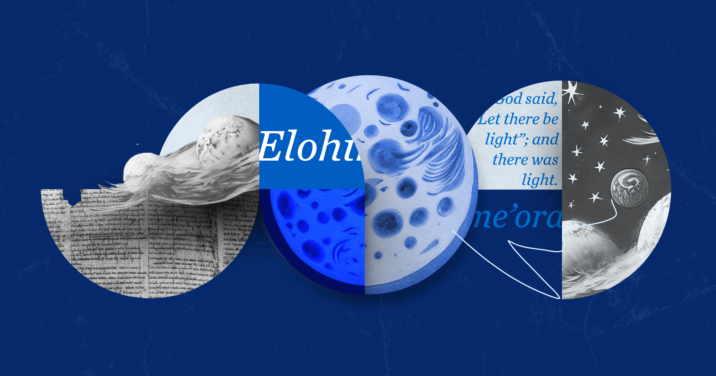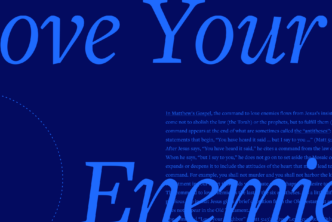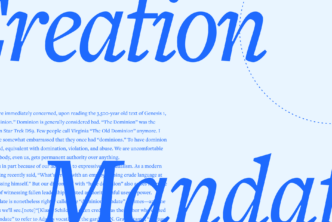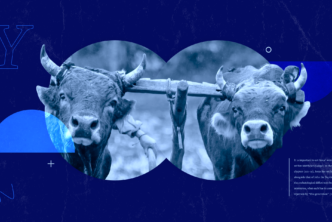The Bible opens by describing a universe that is formless and void. The Creator breaks the silence by speaking a word of power into the nothingness. And then light is introduced, thus marking the first day of creation. Throughout the subsequent five days, the Creator orders and fills the universe with living things. We learn that he is not only the source of all light, but of all life.
This article will pay special attention to day 1, the introduction of light, and day 4, the introduction of the little lights appointed to rule the sky—and how both “lights” passages connect to John 8:12, where Jesus famously says, “I am the light of the world.” I hope you will see how the Creator, Yahweh, who spoke light into the world, became light at the appointed time, and has called us, his image bearers, into his light and out of darkness once and for all.
In the beginning
The narrator of the creation account in Genesis 1 and 2 tells us of the divine origin of the natural world: “In the beginning God created the heavens and the earth.” God—Elohim, as the Hebrew text reads—is the Creator who creates, bara. Bara in Scripture is an action performed exclusively by Elohim; only Elohim creates. The text continues: “The earth was without form and void, and darkness was over the face of the deep.” The first observation is in the phrase, “The earth was without form and void” or as the Hebrew reads, tōhû wāḇōhû.
Old Testament scholar Bruce Waltke points out that these words “are the antonym to the heavens and the earth, signifying something uncreated or disordered.” Tōhû wāḇōhû is also in Jeremiah 4:23–27, which reads:
I looked on the earth, and behold, it was without form and void (tōhû wāḇōhû); and to the heavens, and they had no light. I looked on the mountains, and behold, they were quaking and all the hills moved to and fro. I looked, and behold, there was no man, and all the birds of the air had fled. I looked, and behold, the fruitful land was a desert, and all its cities were laid in ruins before the Lord, before his fierce anger. For thus says the Lord, “The whole land shall be a desolation; yet I will not make a full end.”
Genesis 1:1–2 and Jeremiah 4:23–27 both describe an inhospitable and lifeless world. The difference between the two is that Genesis 1:1–2a describes the moment right before the act of creating is about to begin, while Jeremiah illustrates an “uncreation” by Yahweh. Both examples show the Lord is the agent behind creation and life. There is one Creator who has the power to save or destroy (Jas 4:12) to give or take away life (Job 1:21). It is also interesting to note in both examples there is an absence of light, and subsequently, life.
Genesis 1:2b reads, “And the Spirit of God was hovering over the face of the waters.” In Hebrew it reads, rûaḥ ʾelōhı̂m, which commentators have been discussing for years. Some translations render it as “Spirit of God” (ESV, NIV, NASB) while others render it as “Wind of God” (NRSV). Either way, “Hovering eaglelike over the primordial abyss, the almighty Spirit prepares the earth for human habitation.”1
Key observations:
- Elohim is the only one who can bara.
- In the beginning the world was tōhû wāḇōhû.
- The Spirit of God is present hovering over the face of the waters.
Let there be light
Let’s take a closer look at the subsequent six days of creation, which will fill the formlessness tōhû and the void ḇōhû with an emphasis on “light.” Here is a helpful table from Genesis: A Commentary, by Bruce Waltke and Cathi Fredericks2 (available in Logos, of course):

Genesis 1:3–31 outlines the ordering of creation through a process of six days. As the table above illustrates, days 1–3 focus on creating three spheres: light/darkness, sea/sky, and the dry land with vegetation, which gives us the first picture of a fertile earth. The corresponding three days, days 4–6, focus on filling those spheres: the day rulers/night rulers, sky dwellers/sea dwellers, and the land dwellers (including mankind).3
After six days of creation, the universe is no longer tōhû wāḇōhû, but has been formed, filled, and subsequently ordered. Order was established through the creation of time on days 1–4.
On day one, we’re told in Genesis 1:3,
God said, “Let there be light,” and there was light. And God saw that the light was good. And God separated the light from the darkness. God called the light Day, and the darkness he called Night. And there was evening and there was morning, the first day.
After a full day of bara, the text says, “And there was evening and there was morning, the first day.” After a full workday there is evening, a rest, and then the morning brings a new day of work. With a Word, light is created, and what was tōhû wāḇōhû now has a schedule.
Key observations:
- Elohim has spoken into the tohu wabohu with the words, “Let there be light.”
- Light is the presence of God in creation and the source of all life.
- This light is an establishment of order by introducing time; morning/evening.
Let there be lights
Days 2–3 describe the creation of the skies, seas, and the earth filled with vegetation. Note that in both days, the verses end with, “And it was evening, and there was morning,” which signifies a complete workday, and then rest.
When we get to day 4, Genesis 1:14–19 reads,
And God said, “Let there be lights in the expanse of the heavens to separate the day from the night. And let them be for signs and for seasons, and for days and years, and let them be lights in the expanse of the heavens to give light upon the earth.” And it was so. And God made the two great lights—the greater light to rule the day and the lesser light to rule the night—and the stars. And God set them in the expanse of the heavens to give light on the earth, to rule over the day and over the night, and to separate the light from the darkness. And God saw that it was good. And there was evening and there was morning, the fourth day.
The first thing to note, is the final sentence, “And there was evening and there was morning.” A full day of work has transpired for the fourth straight day. “The incessant mornings are evidence of God’s loving-kindness and faithfulness (e.g., Gen 8:22; Ps 30:5; Lam 3:23).”4
On the fourth day, Elohim said, “Let there be lights,” or, “Let there be me’orah”; that is, “luminous bodies” or “luminaries.” These luminaries are given a job. They are to be, literally translated, “for signs and for seasons, and for days, and for years.” In verse 16, Elohim makes the two lights in the sky to be “rulers” and this is the introduction of royal language into the text. This sets the scene for Elohim setting up his kingly rule (Pss 29; 93; 95–99) over creation: he is allocating his power to the light rulers in the heavens. If we jump forward to the sixth day, we see that mankind, made in Elohim’s image, is allocated to the earth. Elohim says, “Let them have dominion … over the all earth” (Gen 1:26). By the end of the six days of creation, the world has light rulers and earth rulers.
Key observations:
- Elohim has delegated his ruling power to the luminaries “the greater to rule the day and the lesser to rule the night” in the first created sphere.
- This is a creator who shares his power—he does not keep it to himself. It is a demonstration of his steadfast love, faithfulness, and mercy.
- Elohim has instituted seasons. There is a rhythm to the created order.
The light as the presence of the Lord
In the second book of the Torah, Exodus 3 opens with Moses tending his father-in-law’s flock when “the angel of the Lord appeared to him in a flame of fire out of the midst of a bush. He looked, and behold, the bush was burning, yet it was not consumed” (Exod 2:2). This is a demonstration of God’s authority over his creation (the fire does not destroy the bush), as well as a demonstration of his holy presence. As the narrative continues, God says, “Do not come near; take your sandals off your feet, for the place on which you are standing is holy ground” (Exod 2:5). At this point in history, the Israelites are slaves in Egypt and the Lord is calling Moses to lead the Israelites out of captivity and into freedom. It is during this exchange in Exodus 3:13–14 where God reveals his name as “I AM WHO I AM”—or as other translations say, “I am what I am,” or, “I will be what I will be.” This is the introduction of the covenantal name of Yahweh in the Torah.
As the book of Exodus continues, Yahweh shows that he is the one true and living God. He sends ten plagues upon Egypt to demonstrate his power and authority over the entire created order. However, due to Pharaoh’s hardened heart, Yahweh himself delivers his people to freedom. In Exodus 7:14–11, we read of the ninth plague, the plague of darkness, an absence of light. While all of Egypt is sitting in darkness, Yahweh’s covenantal people still have light; they still have Yahweh’s presence with them (Exod 10:23). The Israelites are led out of Egypt by following the presence of the Lord as a pillar of cloud by day and a pillar of fire by night (Exod 13:21). Yahweh went before his people leading and guiding them out of slavery and into freedom.
There is a final example of the association of light with the presence of God in Exodus in 34:29:
When Moses came down from Mount Sinai, with the two tablets of the testimony in his hand as he came down from the mountain, Moses did not know that the skin of his face shone because he had been talking with God.
Key observations:
- We see God’s authority over all his creation.
- Light in the form of fire signifies Yahweh’s presence, glory, and holiness.
- “I AM WHO I AM” comes down and meets with his people.
The light that takes on flesh
Now we turn to the opening verses of the Gospel of John which reads,
In the beginning was the Word, and the Word was with God, and the Word was God. He was in the beginning with God. All things were made through him, and without him was not any thing made that was made. In him was life, and the life was the light of men. The light shines in the darkness, and the darkness has not overcome it.
These opening verses tell us that the Word that was with God was in fact God himself, the Creator of all things, who showed his presence in the primordial abyss. The Light that was spoken into the darkness through a Word that has now become flesh and dwells among us (John 1:14). The power-sharing Creator of Genesis 1 has now pitched a tent among his image-bearers. The Greek word for “dwell” in John 1:14 is skēnoō, which is translated as “to dwell in a tent.” Young’s literal translation renders it by saying that the Word “tabernacled among us.” The Creator is no longer out of reach in the heavens; he is in our midst (Luke 17:21).
The end of John 1:14 reads, “And we have seen his glory.” The glory of God that met with Moses leading the Israelites out of Egyptian captivity demonstrating his steadfast love, is the Word himself, the Light of creation, who is now “tabernacling” among us.
Key observations:
- In the beginning, the Word was with God and was God.
- The Word became flesh and tabernacled among us.
- We have seen his glory.
I am the light
John 8:12 reads, “Again Jesus spoke to them, saying, ‘I am the light of the world. Whoever follows me will not walk in darkness, but will have the light of life.’” The first word, “again” or palin in Greek, forces the reader to think: If Jesus is speaking “again,” then when was the first time Jesus spoke? He must be referring us back to John 7:37–38, where John tells us that it is “the last day of the feast, the great day”—referring to the last day of the Feast of Tabernacles, which was given to the Israelites by God in Leviticus 23:42–43.
You shall dwell in booths for seven days. All native Israelites shall dwell in booths, that your generations may know that I made the people of Israel dwell in booths when I brought them out of the land of Egypt: I am the Lord your God.
The feast was on the fifteenth day of the seventh month, on a Sunday, and it was held to celebrate and remember how the Lord led the Israelites out of Egyptian captivity and provided for them during their forty-year wilderness wanderings. On this day, the Israelites would bring sacrifices to the temple (Num 29:12–40). The concept of having a feast brings us back to the job of the luminaries in Genesis 1:14, day 4 of creation, when God created luminaries for the day and for the night, thus establishing signs for seasons, for days, and for years.
It is on the last day of this feast, the Feast of Tabernacles, where the Word of God who has taken on flesh speaks out, “I am the light of the world.” Immediately, those listening would associate his words with Genesis 1:3 and the presence of the Creator who brought life and order into the tōhû wāḇōhû. Immediately, the Israelites would connect this statement to the light that appeared to Moses and called himself, “I AM WHO I AM.”
Immediately they would remember that this light led them into freedom, provided shelter and food. They would associate this to the God of steadfast love, faithfulness, and mercy whom they are celebrating that very day, in that very moment.
The latter half of 8:12 reads, “Whoever follows me will not walk in darkness, but will have the light of life.” Jesus, the Word, the Light of the world has come. He is the fulfillment of the Feast of Tabernacles. On this day, animal sacrifices would be made—but the ultimate sacrifice, the Lamb of God who takes away the sin of the world, is standing before them (John 1:29–32) at the appointed time.
Key observations:
- John 8:12 takes place on the last day of the Feast of Tabernacles, which is a celebration of God’s faithfulness throughout salvation history.
- Seasons, days, and years were established on day 4 of creation.
- Jesus, the Light of the world, who first brought order into the world, also brings life.
Little lights
We live in a world that is chaotic and is often perceived to be overcome with darkness. I often find myself overwhelmed with life’s obligations, unpredictabilities, injustices, griefs, and anxieties—and yet, John 8:12 says that whoever follows Jesus “will have the light of life.” The light that brought order to the chaos, that brought life into the lifeless, finds its source in a God who not only shared his power but who made you in his very image. Just as he looked into the tōhû wāḇōhû and spoke, “Let there be light,” he looks into your dark, hopeless, anxiety-filled world and says, “I am the light of the world.”
We serve a God of order, not chaos; a God who leads and protects, not who leads astray and abandons. He is a master of all schedules and all seasons. The King of Glory, the Light of the World, holds your hand and says, “Fear not, I am the one who helps you” (Isa 41:13). For we know that the current state of things will not be forever because we have the eschatological hope that one day all things will be restored and we will sit in the presence of the Lord for eternity. As John wrote in the book of Revelation 21:23,
And the city has no need of sun or moon to shine on it, for the glory of God gives it light, and its lamp is the Lamb.
Until then, through the power of the Holy Spirit, we have been charged to “let our lights shine before others” (Matt 5:15). Shine bright, little lights!
Related articles
- What Happened on the 7 Days of Creation?
- What Are the Creation Views on Creation?
- What Does It Mean That All Creation Groans?
- Bruce K. Waltke and Cathi J. Fredricks, Genesis: A Commentary, Logos electronic ed. (Grand Rapids: Zondervan, 2001), 60.
- Waltke and Fredricks, Genesis, 57.
- Tim Mackie introduced this vocabulary to me in his BibleProject Podcast: “Seizing vs. Receiving Power—Firstborn E2.”
- K. A. Mathews, Genesis 1–11:26, vol. 1A, The New American Commentary (Nashville: Broadman & Holman Publishers, 1996), 145.







